All laser operators should be up to date on associated laser risks and standard safety measures for each laser that they use.
Different wavelengths of light are responsible for different ocular damage and therefore appropriate eyewear should be used with each laser treatment.
Corneal eyeshield placement is a safe and effective method of eye protection.
Surgical lubricant can be applied to protect hair, eyelashes and eyebrows from laser treatment
Diligence must be of utmost importance in avoidance of combustible products in the laser treatment field
Safety is of utmost importance in laser treatments for the patient as well as treating physician. All laser operators should be up to date on the associated laser risks and standard safety measures for each machine that they use.
Here we discuss additional safety measures. See Chaps. “Laser-Tissue Interactions” and “Laser Safety: Regulations, Standards and Practice Guidelines” for complete laser safety discussion.
Eye Safety
Unprotected eyes are at great risk for injury during laser treatment from direct or indirect laser beams. Different wavelengths of laser light are responsible for various ocular damage, which can be permanent. As the injury may be painless and the laser beam invisible to the eye, damage can occur inconspicuously. Hence, appropriate eye protection should be consistently used during any laser treatment.
There are different types of eyewear available for protection. For the practitioner, there are optically coated goggles, spectacles and wraps. One must make certain whichever eyewear is used must fit tightly on face and cover entire eye or any additional vision-correction lens. The chosen eyewear should also be of appropriate wavelength and optical density for the laser being employed. The parameters are most often written on the frame of the eyewear. For the patient, when treating non-facial areas, one can use plastic or metal eye shield goggles that completely cover the orbit as well as partial periorbital area. When treating in the facial area, one should use metal corneal eye shields.1,2
Corneal eye shield placement begins with a thorough tray set up (Fig. 1). Choose the appropriate size shield for the patient; sizes range from infant to adult (Fig. 2). Use topical ophthalmic anesthetic (i.e. tetracaine hydrochloride 0.5% ophthalmic solution) for corneal anesthesia followed by lower lid retraction, placement of shield with slight pressure inferiorly. This will allow the upper lid to be placed over shield simultaneously with ease (Figs. 3 and 4). The reverse approach can also be used beginning with upper lid retraction.
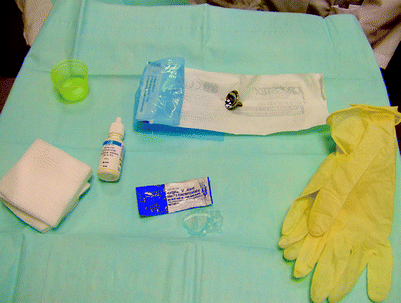
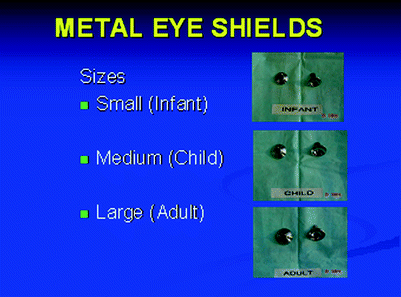
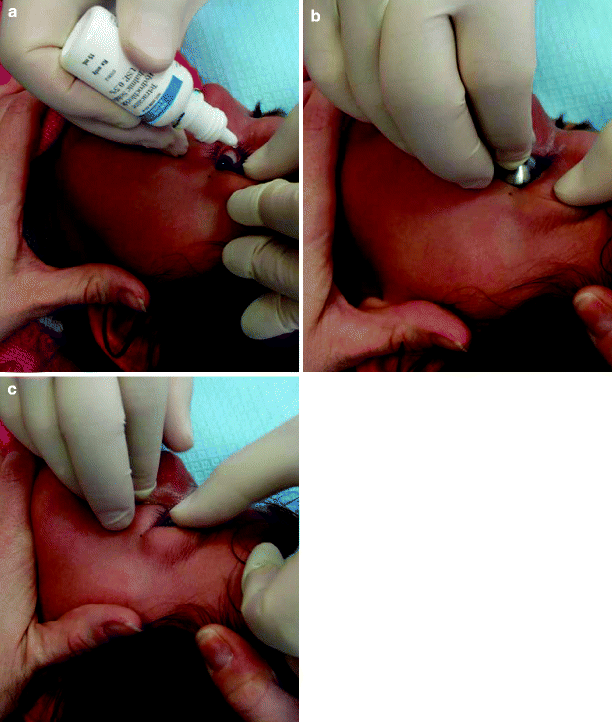
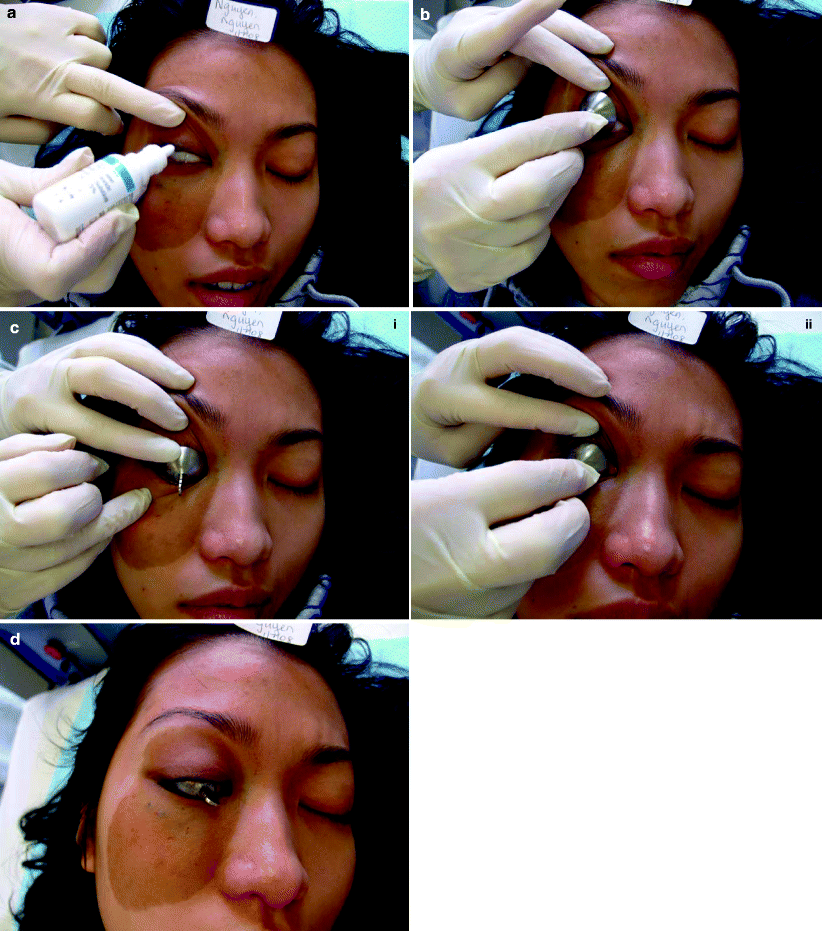

Fig. 1
Tray set up for corneal eye shield placement

Fig. 2
Various sizes of corneal eye shields

Fig. 3
Placement of child corneal eye shield. (a) With upper lid retraction, place ophthalmic drops for mucosal anesthesia; (b) retract upper lid, place shield with slight pressure superiorly; (c) retract lower lid slightly, allowing the lower lid to then slide over the eyeshield. Eyeshield is now in place

Fig. 4
Placement of adult corneal eye shield. (a) Ophthalmic anesthesia is placed; (b) retract upper lid. With slight pressure inferiorly, place adult-sized eyeshield; (c) retract upper lid (i), allowing eyeshield to glide into superior sclera space (ii); (d) adult eyeshield in place
Hair Protection
During periorbital laser treatment, one must be certain to protect the eyelashes and eyebrows, as the laser beam can inadvertently singe these hairs. Surgical lubricant acts as a semi-hydrated coating medium that does not allow laser penetration.
After eye shield placement, use a cotton tip applicator or tongue depressor to apply surgical lubricant to the eyebrows and eyelashes prior to commencement of laser treatment (Figs. 5 and 6). One can also use a tongue depressor to cover the eyebrows in lieu of surgical lubricant for hair protection (Fig. 7).
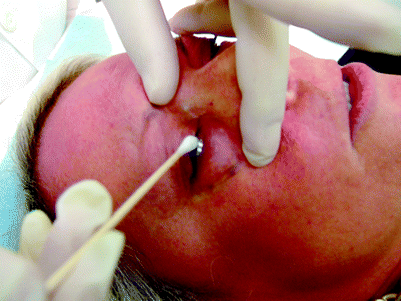
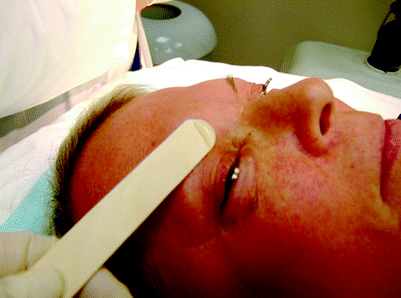
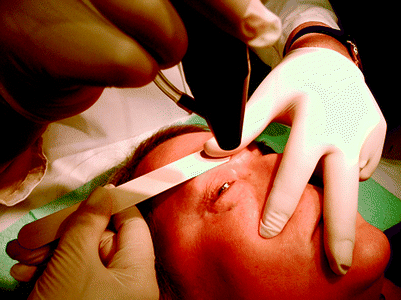

Fig. 5
Application of surgical lubricant on eyelashes

Fig. 6
Application of surgical lubricant on eyebrows

Fig. 7
Tongue depressor to protect eyebrows
Anesthesia Safety
When the laser beam of the pulsed dye laser strikes a combustible object such as oxygen and or nitrous oxide in an endotracheal tube, there is a risk of spontaneous fire eruption. This risk is not only applicable to laser use but also has been reported during electrosurgical coagulation. Regulatory groups as well as laser manufacturers have well documented the items that are at risk for igniting and advise these items be kept out of the laser field; these items include oxygen, nitrous oxide, hair, gauze, paper drapes, clothing, masks, cannulas, airway materials and even flame retardant paper drapes. Therefore, all of these potential ignitable materials must be diligently kept away from the laser field. Those that must remain in the field must be kept wet with saline or water- based lubricant.
Most cases of pulse dye laser treated port wine stains are in office procedures without sedation and its accompanying oxygen supplementation and monitoring equipment. In these cases, one must be cognosent of the aforementioned ignitable materials. When the oxygen supplementation and monitoring equipment is needed in cases of sedation, it is important to choose an airway with lower risk of igniting. Nasal cannulas are an open system and can ignite quite easily. Face masks are not considered a tight seal and therefore can also leak oxygen. Endotracheal tubes are a consideration however, in the pediatric population, there is a greater risk of oxygen leak if the cuff is not tight and during positive pressure ventilation. Colored airways and or masks should not be used, especially green, as they are likely to ignite.
Laryngeal mask airway (LMA) is a device that can be inserted into the patient’s pharynx. With spontaneous ventilation, the LMA prevents oxygen and nitrous oxide leakage by approximately 95%. Leakage is more likely to occur with positive pressure ventilation. In all types of ventilation, one can employ an oxygen analyzer or capnograph to detect oxygen level at airway. Whichever airway is used, one should drape wet gauze around the airway, use a non-flammable petrolatum over hair bearing areas and use ocular shields. When not using the laser it should be placed in standby mode.
Even with all precautions taken, there is still a risk that exists and it is prudent for all staff involved in the patient’s care to be up to date on American National Standard for the Safe Use of Lasers. During all operative room laser procedures, there should always be readily available a basin of water and a fire extinguisher.3
Tattoos
Cosmetic tattoos have higher likelihood of containing ferric oxide or titanium dioxide pigments which darken with Q switch laser treatment. Ablative or fractional ablative laser treatment allow for cosmetic tattoo removal without risk of tattoo pigment darkening. Fractional erbium doped 1,550 nm and fractional CO2 lasers can be employed when treating dark skin patients with known contact allergen to tattoo pigment to minimize risk of anaphylaxis Hypopigmentation seconvdary to laser treatment for tattoo removal can be treated with fractional erbium doped 1,550 nm and fractional CO2 lasers. |
Tattoos come in many forms including amateur, professional, cosmetic, medicinal and traumatic. Laser treatment is a method of tattoo removal with minimal risk of scarring particularly when compared with alternative tattoo removal methods such as dermabrasion or surgical excision. Amateur tattoos are generally easier to treat than professional tattoos as the ink is usually more superficial and of less dense particles. Multicolor tattoos will require different lasers in order to treat the various colors. Double treated, densely pigmented and multi-colored tattoos are more likely to be recalcitrant to laser therapy. See Chap. “Laser Treatment of Tattoos” for complete discussion of laser tattoo removal.
Cosmetic Tattoo Removal
Cosmetic tattoos are generally composed of pigments in the beige, white and red families of which most contain ferric oxide or titanium dioxide pigment. When exposed to Q switch lasers, oxidation of the pigment to ferrous oxide occurs, resulting in an immediate pigment darkening.4,5
Stay updated, free articles. Join our Telegram channel

Full access? Get Clinical Tree








